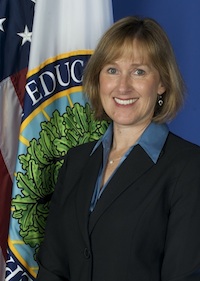Powering Up Learning with Technology
Technology is about how we bridge the gap between what students learn in school and what they do outside of school, according to Karen Cator, director of the ED's Office of Education technology. She spoke Wednesday to a crowd gathered at the FETC 2011 conference in Florida, where she elaborated on some of the goals of the National Education Technology Plan (NETP).

Karen Cator: 21st century learning is "like training for the next Olympics, but we're not going to tell you which sport." |
As director of the Office of Educational Technology in the United States Department of Education, Karen Cator is acutely aware of the challenges facing both twenty-first century learners and the educators who teach them. "A lot has changed," she said, addressing hundreds of professionals during her address at the FETC 2011 conference in Orlando, FL Wednesday. "A lot is going on, and now is the time to really figure out how to power up learning by using technology." And that, she continued, is where the National Education Technology Plan (NETP)--released in November 2010--comes in.
According to Cator, Education Secretary Arne Duncan and President Obama are serious about the recently stated goal that, "by 2020, America will once again have the highest proportion of college graduates in the world." But, she went on, we can't do this if we don't take seriously the necessity of technology to power the workforce. "We need an entire generation of people that can operate in a new environment" built on mastery of 21st century skills.
This is not just about competition, she said, but about interdependence and understanding that innovation is a necessary response to what she described as our growing interconnectedness.
After briefly polling the audience for examples of how teachers in the field are using technology to "power education" (with responses that included 100 percent online math and STEM programs), Cator laid out several reasons the current educational landscape needs to change:
- The increasing mobility of our global society;
- Expanded social interactions that create powerful opportunities for learning;
- Increased access and availability of digital content; and
- The move toward blended learning environments that merge the classroom experience with rich, online interactions.
Cator was quick to point out that the current NETP is "completely focused on education. It's about learning," she said, "not about devices," and it's critical we make people aware of that. "This is about connecting formal and informal learning; it's about figuring out how we get students to connect what they're doing in school with what they're doing outside of school." Technology, she insisted, is how we bridge that gap.
The plan itself is divided into five key areas, including learning, assessment, teaching, infrastructure, and productivity. Each area is focused on a core set of goals that are, according to Cator, firmly grounded in research.
1. Learning
Learning, she said, is fundamentally about 21st century expertise. "It's like training for the next Olympics, but we're not going to tell you which sport." It's general training that's really more about cultivating the ability to adapt than it is about learning a single, narrow skill set. This type of learning focuses on:
- Flexibility;
- Personalized learning catered to the individual student;
- Universal design of curriculum and tools; and
- Creation of persistent profiles for students.
2. Assessment
Assessment, said Cator, is intended to improve learning by measuring what matters through the entire range of standards, rather than by creating an arbitrary set of benchmarks that do little to improve real world skills. Characteristics include:
- Embedded assessments that happen during the learning process;
- Real-time feed back to aid in improving performance; and
- Portfolios and learning records that act as a map for individualized instruction.
3. Teaching
This one's important, said Cator. "We need to be clear about technology's role in teaching. Technology," she emphasized, "is going to support teaching, not replace it." This type of teaching must be:
- Highly effective;
- Collaborative;
- Connected to tools, resources, experts, and peers;
- Based on differentiated roles; and
- Able to leverage expertise in the cloud.
4. Infrastructure
As a critical component of this new type of instruction, infrastructure must, in Cator's view, adequately support the needs of the 21st century learner. Critical components include:
- 24/7 access that is truly community-wide;
- Adequate access to broadband;
- Support that is driven by best practices across the learning community; and
- Equitable access to the entire array of technology resources.
5. Productivity
Productivity in this sense is not about how much a student does, Cator said. It's really about every student doing what is most useful to them every day. It's about building a more productive way of thinking about education, and includes:
- Process redesign to improve the delivery of technology assets and resources;
- Refinement of metrics to determine use cases and best practices; and
- Establishment of interoperability standards that come form the educators in the field.
The real goal, said to Cator, is figuring out "how we leverage the best online environments that are incredibly participatory, that get people to work together to solve problems." It's about moving from a seat-based system to a productivity-based system that connects learners across subjects and programs. The challenge, she insisted, is "creating a scalable, sustainable ecosystem where we can share practice, access, and solutions that improve the opportunities to learn."
About the Author
Chris Riedel is a freelance writer based in Illinois. He can be reached here.